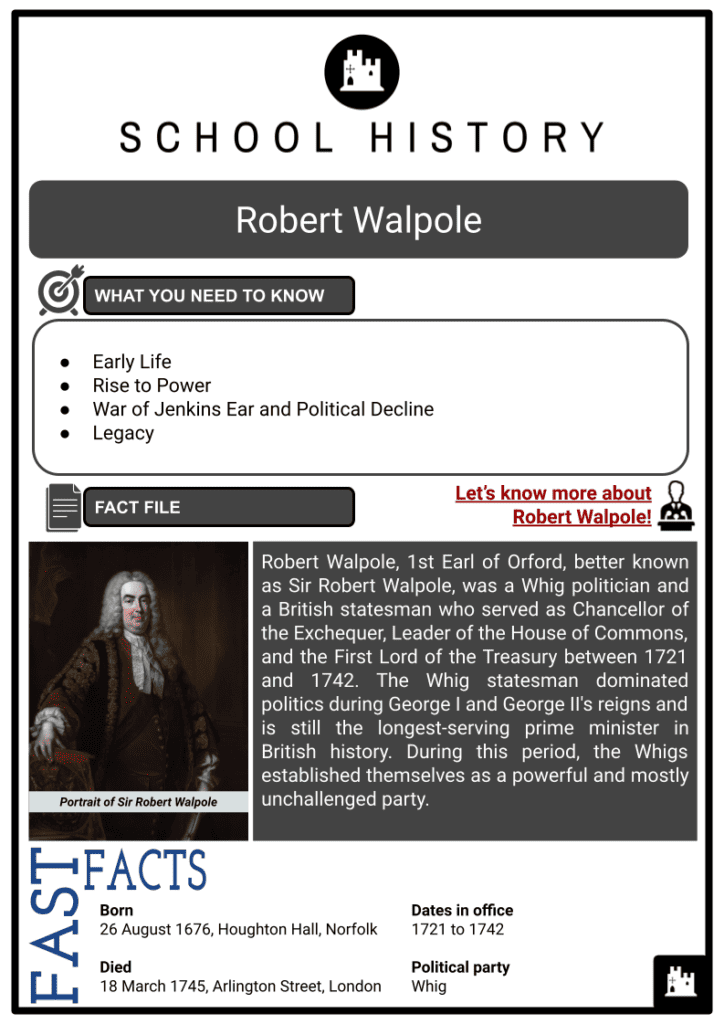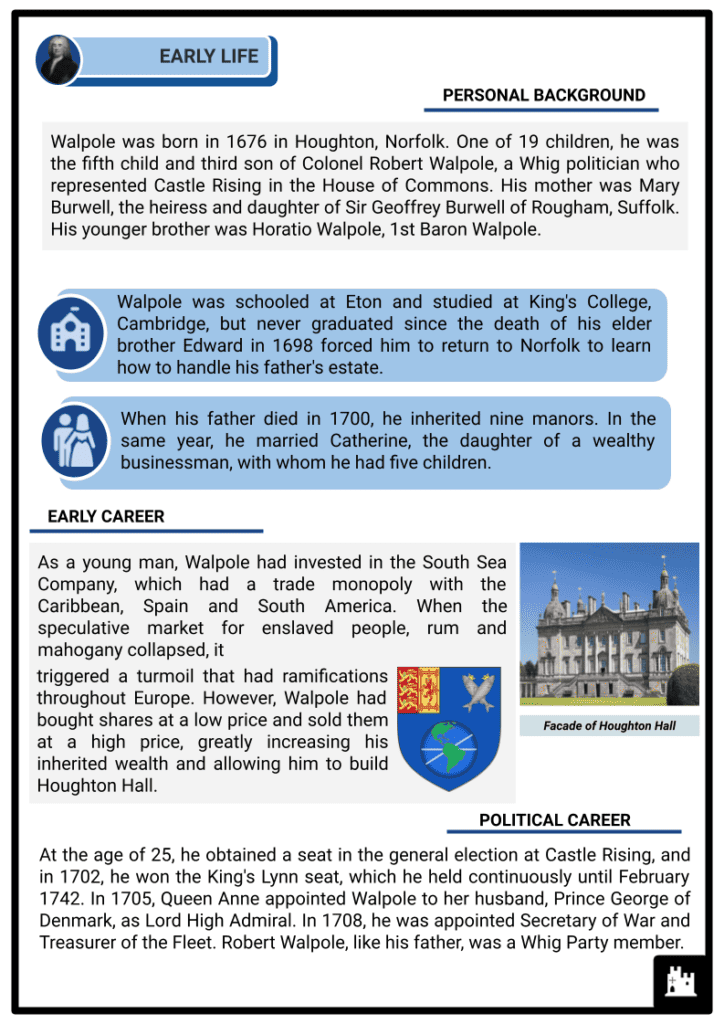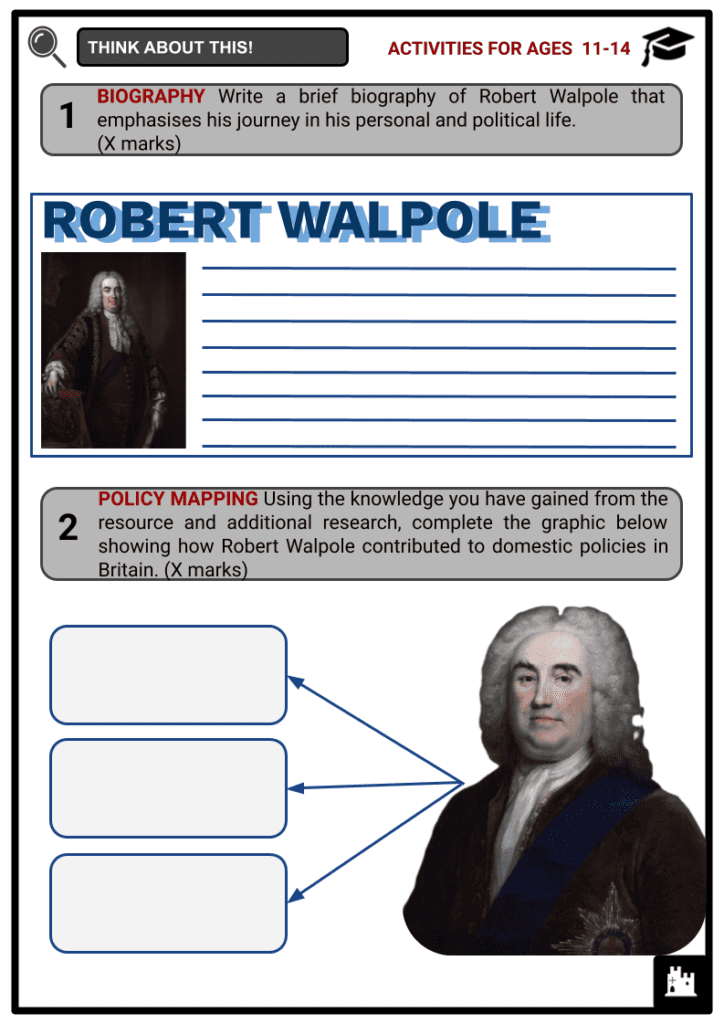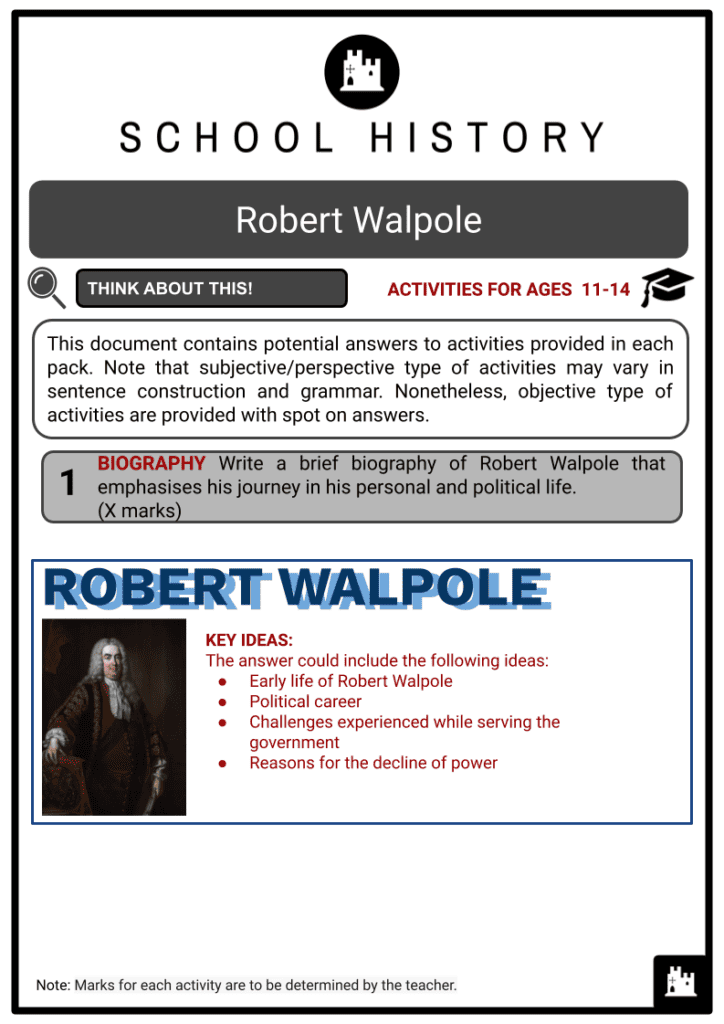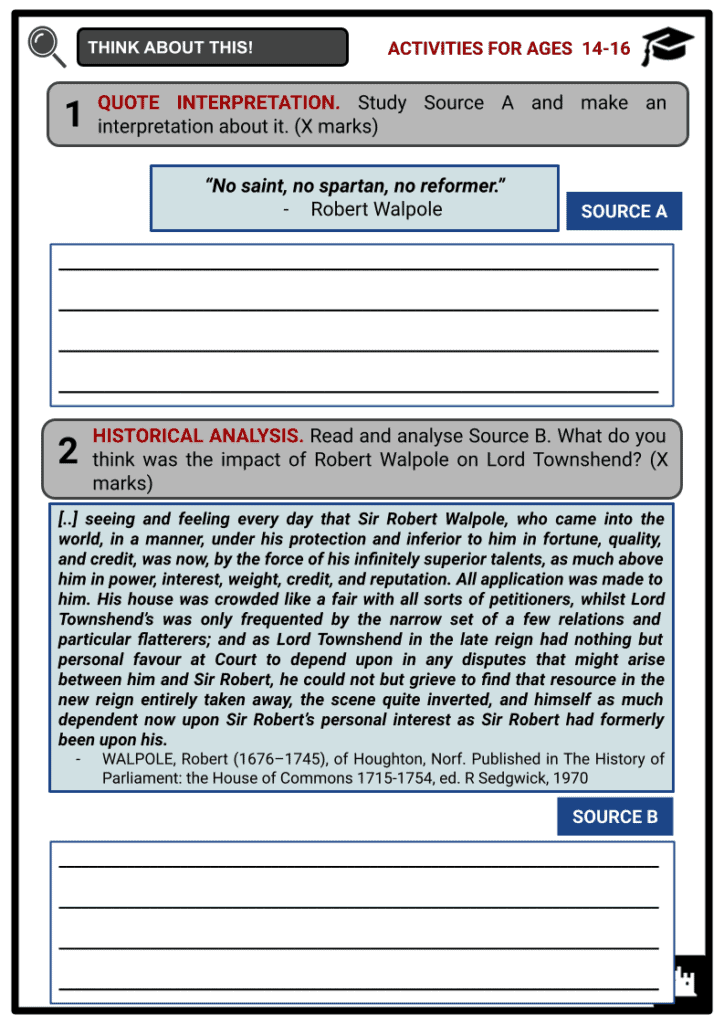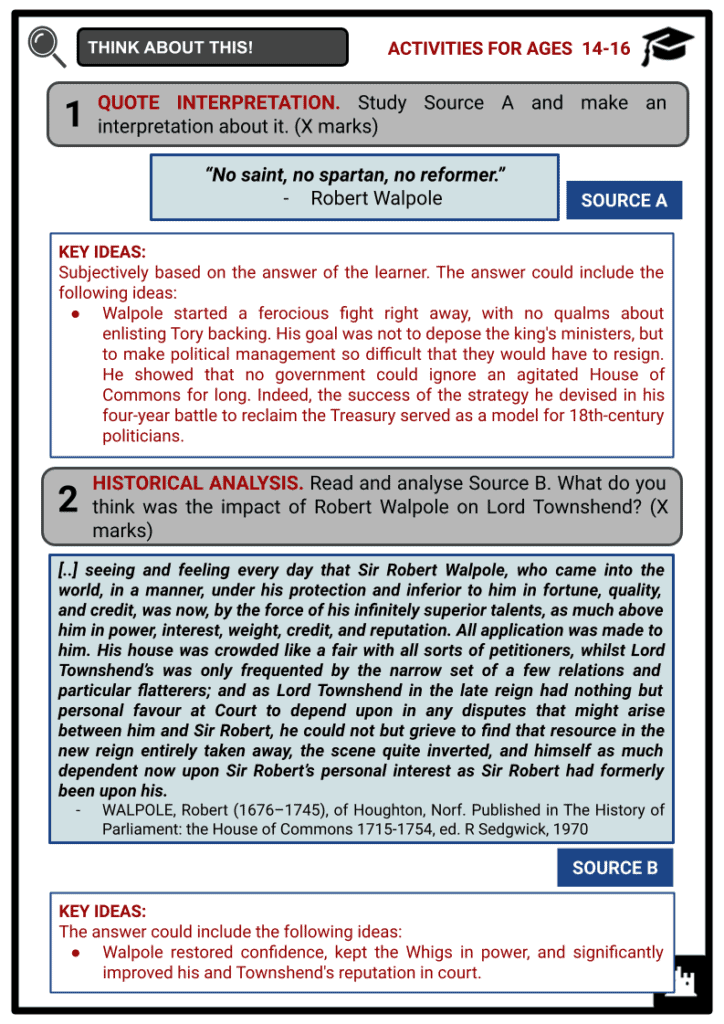Robert Walpole Worksheets
Do you want to save dozens of hours in time? Get your evenings and weekends back? Be able to teach about Robert Walpole to your students?
Our worksheet bundle includes a fact file and printable worksheets and student activities. Perfect for both the classroom and homeschooling!
Summary
- Early Life
- Rise to Power
- War of Jenkins Ear and Political Decline
- Legacy
Key Facts And Information
Let’s know more about Robert Walpole!
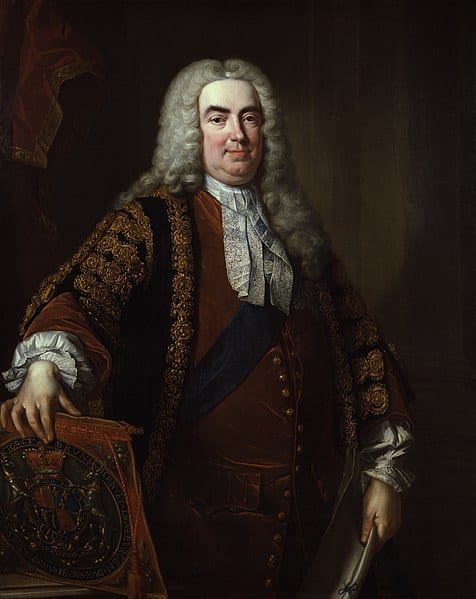
Robert Walpole, 1st Earl of Orford, better known as Sir Robert Walpole, was a Whig politician and a British statesman who served as Chancellor of the Exchequer, Leader of the House of Commons, and the First Lord of the Treasury between 1721 and 1742. The Whig statesman dominated politics during George I and George II's reigns and is still the longest-serving prime minister in British history. During this period, the Whigs established themselves as a powerful and mostly unchallenged party.
Fast Facts
- Born26 August 1676, Houghton Hall, Norfolk
- Died18 March 1745, Arlington Street, London
- Dates in office1721 to 1742
- Political partyWhig
EARLY LIFE
PERSONAL BACKGROUND
- Walpole was born in 1676 in Houghton, Norfolk. One of 19 children, he was the fifth child and third son of Colonel Robert Walpole, a Whig politician who represented Castle Rising in the House of Commons. His mother was Mary Burwell, the heiress and daughter of Sir Geoffrey Burwell of Rougham, Suffolk. His younger brother was Horatio Walpole, 1st Baron Walpole.
- Walpole was schooled at Eton and studied at King's College, Cambridge, but never graduated since the death of his elder brother Edward in 1698 forced him to return to Norfolk to learn how to handle his father's estate.
- When his father died in 1700, he inherited nine manors. In the same year, he married Catherine, the daughter of a wealthy businessman, with whom he had five children.
EARLY CAREER
- As a young man, Walpole had invested in the South Sea Company, which had a trade monopoly with the Caribbean, Spain and South America. When the speculative market for enslaved people, rum and mahogany collapsed, it triggered a turmoil that had ramifications throughout Europe. However, Walpole had bought shares at a low price and sold them at a high price, greatly increasing his inherited wealth and allowing him to build Houghton Hall.
POLITICAL CAREER
- At the age of 25, he obtained a seat in the general election at Castle Rising, and in 1702, he won the King's Lynn seat, which he held continuously until February 1742. In 1705, Queen Anne appointed Walpole to her husband, Prince George of Denmark, as Lord High Admiral. In 1708, he was appointed Secretary of War and Treasurer of the Fleet. Robert Walpole, like his father, was a Whig Party member.
Brief timeline of Walpole's early political career
- 1705 Queen Anne nominated Walpole to her husband's council, Lord High Admiral Prince George of Denmark.
- 1708 Walpole was appointed as the Secretary of War.
- 1711 Walpole was dismissed from his position as Secretary of War, but he remained Treasurer of the Navy until 2 January.
- 1712 Walpole was charged with venality and corruption in two forage contracts for Scotland.
IMPRISONED IN THE TOWER
- Walpole was imprisoned in the Tower of London for six months and expelled from Parliament after being found 'guilty of a high breach of trust and renowned corruption', during which time essential personalities visited him. He became a Whig martyr and national celebrity.
- After his release, he was re-elected to the seat of King's Lynn in 1713, named privy councillor and paymaster general in 1720, and paymaster of the forces: 'Robert Walpole, Esq; is appointed Paymaster-General of His Majesty's Forces.'
RISE TO POWER
- In April 1721, Walpole was given tasks in the government following the resignation of Whig opponent Charles Spencer, 3rd Earl of Sunderland, and the death of James Stanhope. The term ‘prime minister' was not frequently used then, yet Walpole held this powerful office until 1742.
- In his first year, Walpole helped Parliament resolve the South Sea Company's financial collapse scandal while also resolving his own issues with investments he made in the company before its demise.
- Walpole's de facto stint as 'prime minister' is commonly dated to his appointment as First Lord of the Treasury in 1721. Though he refused that title, in 1741, he remarked: 'I unequivocally deny that I am sole and prime minister.'
- His brother-in-law, Lord Townshend, was Secretary of State for the Northern Department and was in charge of the country's international affairs. They also had to deal with Lord Carteret, Secretary of State for the Southern Department. Townshend and Walpole were returned to power and promised to destroy the opposing faction.
PREMIERSHIP UNDER GEORGE I
- The first year of Walpole as a prime minister was highlighted by the revelation of a scheme devised by the bishop of Rochester, Francis Atterbury. The scheme's disclosure dashed the aspirations of the Jacobites, whose earlier rebellions had also failed. Although Lord Bolingbroke, a Tory leader who fled to France to escape punishment for his Jacobite sympathies, was given permission to return to Britain in 1723, the Tory Party suffered the same fate.
- Throughout the remainder of George I's reign, Walpole's ascendancy continued: the monarch's political power gradually diminished while that of his ministers gradually increased.
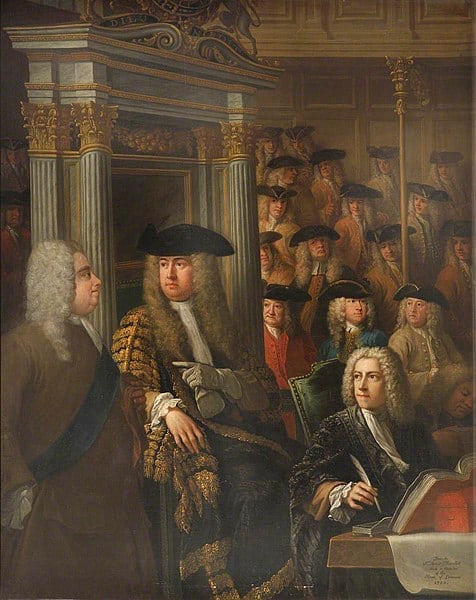
Portrait depicting Speaker Arthur Onslow calling upon Sir Robert Walpole to speak in the House of Commons by William Hogarth - Townshend worked with the monarch to keep the country at peace, mainly by forging a pact with France and Prussia in 1725. According to Walpole, who was unconcerned, Townshend was 'too precipitate' in his activities.
- Great Britain prospered, free of Jacobite threats, war and financial crises, and Robert Walpole gained George I's favour. In 1725, he persuaded the king to reinstate the Knighthood of the Bath, and he was named a Knight of the Garter in 1726, gaining him the nickname 'Sir Bluestring'. Walpole's eldest son received a barony during this period.
SIR BLUESTRING
- In 1735, George II gave Walpole 10 Downing Street, the permanent London residence of British prime ministers ever since. Walpole declined the land as a personal gift, instead requesting that the monarch make it accessible to him and future First Lords of the Treasury as an official residence. Walpole's policy of avoiding armed conflict helped his popularity during his leadership. In 1734, he told Queen Caroline (with whom he had secured favour), 'Madam, there are fifty thousand men slain this year in Europe and not one Englishman.'
ACTS PASSED UNDER WALPOLE
- Parliamentary Privilege Act 1737.To amend an act made in the 12th and 13th years of King William the Third's reign, which established 'An act for preventing any Inconveniences that may happen by Privilege of Parliament.'
- Distress for Rent Act 1737Act that aimed for more effective rent collection and the prevention of tenant fraud.
- Gaming Act 1738An act to combat excessive and deceptive gaming.
WAR OF JENKINS AND POLITICAL DECLINE
- A war between Britain and Spain erupted due to Britain's trade with South America. The Peace of Utrecht, which granted the British South Sea Company a limited trade monopoly with the Spanish American colonies, produced considerable conflict. Still, the significant troublemakers were illegal traders who resisted the company and the Spanish government.
- The war was named after Robert Jenkins, the owner of the ear. He was a British sea captain whose ear was claimed to have been chopped off by Spanish coast guards who intercepted and searched his ship Rebecca.
- The incident received an apathetic response until opposition members in Parliament, backed by the South Sea Company, used it seven years later to rouse support for a war against Spain in the hope of improving British trading prospects in the Caribbean.
- They also wanted to keep the profitable Asiento de Negros, which allowed British slave traffickers to sell enslaved people in Spanish America, which is why it is known as the Guerra del Asiento in Spanish. Unsuccessful British raids on Cartagena and Havana ports in 1741 resulted in enormous fatalities, mostly from disease, and were never repeated.
- Apart from minor fighting in Florida and Georgia, the conflict was primarily subsumed into the War of the Austrian Succession after 1742, which involved most of Europe's powers and ended with the Treaty of Aix-la-Chapelle in 1748. Admiral George Anson's worldwide sailing from 1740 to 1744 is recognised in British naval history.
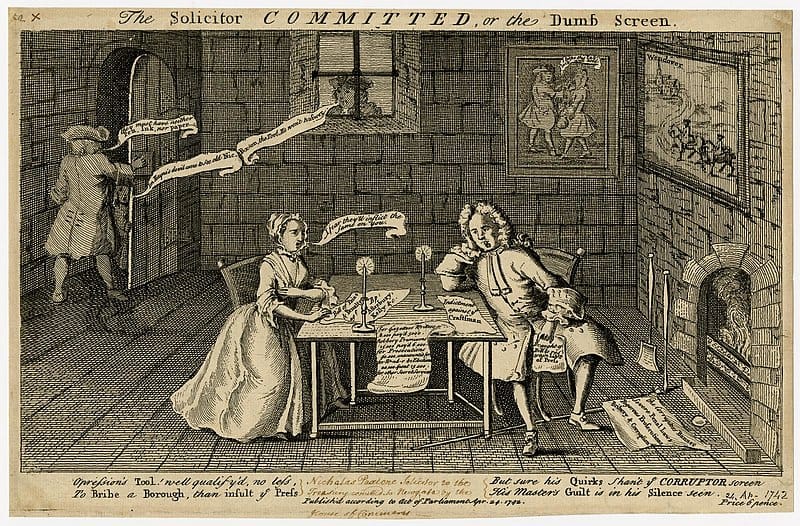
Satire about Nicholas Paxton, counsel to the Treasury, and his unwillingness to respond to queries from the Committee of Secrecy investigating Robert Walpole's actions. - The War on Jenkins led to the decline in fortune for Robert Walpole. Walpole could no longer command the situation, and his support at court was decreasing. His second wife, Maria Skerrett, died in 1737, and his health was much affected by grief. This exacerbated Walpole's already decreasing popularity and growing resistance among Tories and his party, as seen by the Whigs' bad general election performance in 1741.
- Walpole resigned in February 1742 after losing a motion of confidence. In the same year, he was given the title of 1st Earl of Orford, and deemed 'pensioned off' in specific ways, albeit retaining the king's favour.
LATER LIFE
- Lord Wilmington succeeded Lord Orford as prime minister in an administration led by Lord Carteret. A committee was formed to investigate Walpole's government, but no significant evidence of misconduct or corruption was found. Though no longer a Cabinet member, Orford maintained personal influence with George II, earning him the moniker 'Minister behind the Curtain' for his advice and effect.
- In 1744, he was able to force Carteret's resignation and the appointment of Henry Pelham, whom he considered a political protégé. He recommended that Pelham use his Commons position to link the king and Parliament, as Walpole had done. During this time, Walpole also made two Lord's interventions. The first occurred in January 1744, during the argument over keeping Hanoverian troops on British pay. Walpole kept the troops from being lost. In his second intervention, Walpole made a statement on the issue, fearing a Jacobite-inspired invasion in February 1744.
- In his final years, Walpole relished the delights of the hunt alongside his political concerns. Such activities were denied to him at his recently rebuilt country house in Houghton, Norfolk, due to 'dismal weather'.
- His health, which had never been good, began to deteriorate rapidly towards the end of 1744. Walpole died of a bladder stone on 18 March 1745, in London, at 68 and received a burial at Haughton estate, specifically at the Church of St Martin at Tours.
LEGACY
- Walpole wielded enormous power in the politics of his day. The Tories were reduced to a little unimportant faction, while the Whigs rose to become a strong and primarily unchallenged party. Despite being regarded as Great Britain's first prime minister, his influence on the development of the uncodified constitution of Great Britain was less significant.
- Walpole's peacekeeping strategy contributed significantly to the country's prosperity. Walpole also managed to keep the Hanoverian Dynasty in power and skillfully countered Jacobitism. The defeat of the 1745 insurrection removed the Jacobite menace shortly after Walpole's term ended.
- 10 Downing Street is another piece of Walpole's legacy. In 1732, George II presented this property to Walpole as a gift. Still, Walpole only took it as the official abode of the First Lord of the Treasury, moving there on 22 September 1735.
- Walpole drew the attention of heterodox economists as a pioneer of protectionist policies such as tariffs and subsidies to woollen mills. As a result, the industry became the country's principal export, allowing it to purchase the raw materials and food that drove the industrial revolution.
He was an honorable man and a sound Whig. He was not, as the Jacobites and discontented Whigs of his time have represented him, and as ill-informed people still represent him, a prodigal and corrupt minister. They charged him in their libels and seditious conversations as having first reduced corruption to a system. Such was their cant. But he was far from governing by corruption. He governed by party attachments.
- Edmund Burke, Anglo-Irish Statesman
Image Sources
- https://en.wikipedia.org/wiki/File:Robert-Walpole-1st-Earl-of-Orford.jpg
- https://en.wikipedia.org/wiki/File:William_Hogarth_(1697-1764)_-_Speaker_Arthur_Onslow_Calling_upon_Sir_Robert_Walpole_to_Speak_in_the_House_of_Commons_-_1441463_-_National_Trust.jpg
- https://en.wikipedia.org/wiki/File:The_Solicitor_Committed,_or_the_Dumb_Screen_(BM_1868,0808.3700).jpg

